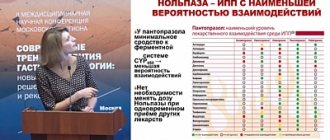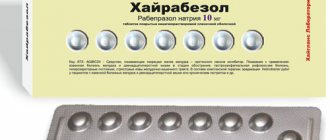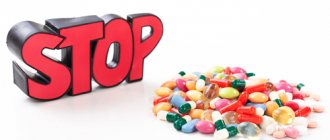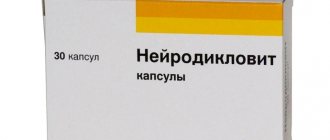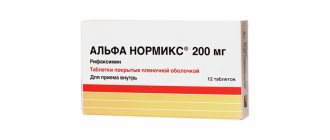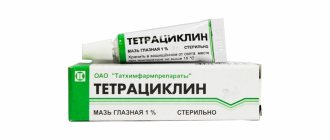Compound
The composition of the drug (1 tablet) includes the following active ingredients: 50 mg of rutoside , 345 units of pancreatin , 225 units of bromelain , 90 units of papain , 360 units of trypsin , 50 units of amylase , 34 units of lipase , 300 units of chymotrypsin (and pancreatin is presented in units ( ED) of the European Pharmacopoeia, and the remaining ingredients in units (U) of the International Pharmaceutical Federation).
Additional ingredients: stearic acid, lactose, talc, corn starch, purified water, magnesium stearate, colloidal silicon dioxide.
Shell composition: povidone, shellac, sucrose, methyl methacrylate-methacrylic acid copolymer, vanillin, talc, white clay, titanium dioxide, macrogol 6000, carnauba wax, triethyl citrate, bleached wax, dyes (crimson 4R and yellow-orange S).
Pharmacodynamics and pharmacokinetics
According to Medical Wikipedia (MedViki), the drug Wobenzym is a complex of highly active animal and plant enzymes ( enzymes ). These enzymes are carefully selected, optimally combined and included in Wobenzym tablets, which gives them a fairly wide range of clinical applications.
Taking Wobenzym has a positive effect on the course of the inflammatory process , reduces the pathological symptoms of immunocomplex and autoimmune reactions , and has a positive effect on the immunological reactivity of the human body. Under the influence of the active ingredients of the drug, the number of immune complexes the blood and their membrane deposits are removed from the tissues. The drug activates and corrects the functionality of natural killer cells ( lymphocytes ) and monocyte-macrophages , stimulates phagocytic cellular activity, cytotoxic T-lymphocytes and antitumor immunity , for which Wobenzym is often prescribed as an immunomodulator .
Treatment with Wobenzym reduces the infiltration of interstitial tissue by plasma cells , increases the elimination of deposits of fibrin and protein detritus from the inflamed area, accelerates the lysis of metabolic toxins and dying tissue structures, reduces swelling , accelerates the resorption of hematomas , and also normalizes the permeability of vascular walls.
The use of the drug leads to a decrease in thromboxane , a decrease in platelet aggregation , stabilization of blood cell adhesion, an increase in the plasticity of red blood and their ability to change their own shape, normalization of the number of platelets and a decrease in the total number of their activated fractions, regulation of blood viscosity and a decrease in the total number of microaggregates . the rheological parameters of the blood and its microcirculation improve , which ensures a normal supply of tissues and organs of the human body with nutrients and oxygen.
Wobenzym reduces the replication of endogenous cholesterol , normalizes lipid , increases HDL , reduces the content of atherogenic lipoproteins and improves the absorption of polyunsaturated fatty acids .
The administration of Wobenzym enhances the effectiveness of antibiotic therapy by increasing the level of antibacterial agents in the source of inflammation and their plasma concentrations, triggers the process of nonspecific defense of the body (production of interferons ), thereby exhibiting antimicrobial and antiviral effects, and also eliminates the symptoms of dysbiosis . The drug also reduces the severity of side effects that occur when taking hormonal medications (including hypercoagulation ).
When taken orally, due to the resorption of dimeric molecules , the active ingredients of Wobenzym are absorbed from the small intestine with the formation of protein complexes and further entry into the vascular bed. Circulating through the systemic bloodstream, enzymes enter areas of pathological processes, where they accumulate.
Wobenzym, 200 pcs., enteric-coated tablets
WOBENZYME is a combination of highly active proteolytic enzymes (proteases) of plant and animal origin, exhibiting stable pharmacological activity. When combined, enzymes have a pleiotropic (multiple) effect, having diverse effects on different target organs and biochemical processes. The drug's proteases realize their systemic effects through immunomodulatory, antiplatelet, fibrinolytic, decongestant, thrombolytic and secondary analgesic effects.
An important ability of the drug enzymes immobilized by endogenous antiproteases is the ability to move in the vascular bed and be present in various organs and tissues, which has important therapeutic significance in systemic inflammatory processes and lesions. The preparation realizes the ability of enzymes of plant and animal origin to cooperate and synergize, due to which their action is enhanced and complementary.
Entering the body, tablets of the drug, coated with a protective enteric coating, pass transiently through the upper gastrointestinal tract without injuring the stomach and without participating in digestion. The protective coating of the tablets dissolves in the small intestine, and the enzymes of the drug migrate through the intestinal wall (endocytosis, pinocytosis).
Some of the proteolytic enzymes of the drug are absorbed by resorption of intact molecules and form complexes with transport proteins in the blood - antiproteases (α-2-macroglobulin and α-1-antitrypsin). When combined with antiproteases, the proteolytic enzymes of the drug change the conformational structure of the transport macromolecules of antiproteases, as a result of which the antiproteases pass into an active form capable of regulating the level of cytokines, growth factors and hormones in the vascular bed.
The formation of a protease-antiprotease complex makes it possible to slow down the removal of exogenous proteolytic enzymes of the drug from the body and increase their circulation time in the bloodstream. In the complex, there is no irreversible inactivation of exogenous enzymes; they retain their activity and reactivity towards specific substrates with affinity for proteases.
Antiprotease (α-2-macroglobulin) masks the antigenic determinants of drug protease macromolecules, which ensures the movement of enzymes through the vascular bed without causing an allergic reaction of the immune system and their delivery to remote areas to the site of inflammation, regardless of the localization of the pathological process in the body.
Under the influence of the enzymes of the drug, the activated form of α-2-macroglobulin acquires the ability to regulate the level of pro-inflammatory cytokines and growth factors, carrying out their sorption, transportation and clearance. Thus, the enzymes of the drug indirectly, through the activation of endogenous antiproteases, can regulate the transition of a pro-inflammatory immune response to an anti-inflammatory one. Proteolytic enzymes interrupt the pathological cascade of inflammation, optimize the course of inflammation and prevent the transition of the inflammatory process to the chronic stage.
Activated antiproteases regulate the level of transforming growth factor β (TGF-β) in the circulation due to its sorption and elimination. TGF-β has an autocrine nature of regulation, which makes its control difficult, and is responsible for replacing damaged areas of organs with connective tissue. The enzymes of the drug indirectly through antiproteases reduce the level of TGF-β, i.e. regulating reparative processes, physiological growth of connective tissue and scar formation, while preventing the formation of a keloid scar and the development of adhesive disease.
Part of the proteolytic enzymes of the drug remaining in the intestine enters into digestive reactions, improves the breakdown of proteins, fats, carbohydrates and other substrates, and also helps restore the intestinal ecology and microbial balance between autochthonous (related) and opportunistic microflora.
The drug's enzymes have a positive effect on the course of the inflammatory process, limit the pathological manifestations of autoimmune and immune complex processes, restoring the body's immunological reactivity. The drug's proteases accelerate the breakdown of inflammatory mediators, normalize the activity of the complement system, stimulate and regulate the level of functional activity of monocytes-macrophages, natural killer cells and activate antitumor immunity. The drug reduces the level of pro-inflammatory cytokines (IL-1β, IL-6, IL-8, TNF-α, INF-γ) and increases the production of anti-inflammatory cytokines (IL-4, IL-10), regulates the level of Ig and antibodies, i.e. O. providing a multifaceted immunomodulatory effect, increasing the activity of phagocytes and stimulating interferonogenesis.
Under the influence of drug proteases, there is a decrease in the number of circulating immune complexes (antigen-antibody) and membrane deposits of immune complexes with acceleration of their elimination (removal) from tissues due to shedding (cleavage) of immune complexes and a decrease in the density of adhesive molecules.
The drug reduces the infiltration of the interstitium with plasma proteins, increases the elimination of protein detritus (cellular fragments) and fibrin deposits in the area of inflammation, accelerates the lysis of toxic products and necrotic tissues, i.e. improving tissue trophism, helping to reduce swelling and improve the penetration of drugs into the site of inflammation.
The enzymes of the drug optimize the physiological course of reparative processes, accelerate the resorption of hematomas and edema, normalize the permeability of vascular walls, improve microcirculation and trophic processes in the damaged area, reduce oncotic pressure in tissues, i.e. accelerating healing and recovery.
The drug reduces the concentration of thromboxane and platelet aggregation (sticking together), reduces the expression of adhesive molecules and the adhesion of blood cells on the endothelium, increases the ability of red blood cells to change their shape (deformability), improving their plasticity for passing vascular bifurcations, which promotes the effective delivery of oxygen to tissues.
The drug activates the blood anticoagulant system, helps restore the number of discocytes, reduces the number of activated forms of platelets, reduces the total number of platelet microaggregates, normalizes blood viscosity, i.e. improving the rheological properties of blood and microcirculation in tissues. The proteolytic enzymes of the drug increase the fibrinolytic activity of blood plasma, activate endothelial function, improve lymph flow, oxygen supply to tissues and improve metabolism in the body.
The drug reduces the risk of developing undesirable effects associated with taking hormonal drugs (hypercoagulation, platelet activation, thrombus formation, blood thickening).
The drug has a pronounced antioxidant effect, reduces lipid peroxidation, and normalizes lipid metabolism. The proteolytic enzymes of the drug reduce the level of endogenous cholesterol, increase the content of HDL, and reduce the level of LDL, i.e. exhibiting antiatherogenic effect. The drug improves the metabolism of polyunsaturated fatty acids, increases the antioxidant activity of plasma, reduces oxidative stress and helps prevent the development of systemic inflammation.
The proteolytic enzymes of the drug interrupt communications and intercellular interaction between bacteria, impede the formation of membranes and the matrix of biofilms, disrupt the growth of microbial colonies in biofilms (in vitro)
. Thus, the enzymes of the drug create favorable conditions for the penetration of antibiotics into microbial communities (biofilms), increasing the effectiveness of antibiotic therapy. The drug's proteases interrupt the frequency of transmission of antibiotic resistance factors (plasmid genes) between bacteria in microbial colonies, while reducing the risk of developing resistance to antibiotics. Violation by enzymes of cooperation and communication between bacteria to form a protective mechanism - biofilm, makes bacteria more vulnerable to antibiotics. The drug creates conditions for increasing the concentration of antibiotics at the site of infection, which increases the effectiveness of antibacterial therapy.
The drug's enzymes reduce the undesirable side effects of antibiotic therapy (dysbiosis, irritable bowel syndrome) by improving food digestion, breaking down substrates, normalizing microflora and restoring intestinal endoecology.
Proteases of the drug activate natural mechanisms of non-specific defense, increase the production of interferons, IgA and lysozyme, i.e. realizing antiviral and antimicrobial actions.
Indications for use of Wobenzym
The abstract for Wobenzym positions it as a means for use in combination with other drugs used for the treatment of certain pathologies, as an addition to the main treatment. Indications for the use of the drug cover many areas of medicine and recommend its use in the following cases.
In angiology:
- lymphatic;
- thrombophlebitis;
- endarteritis;
- postthrombophlebitic disease;
- arterial obliterating atherosclerosis of the legs;
- recurrent phlebitis (prevention).
In gynecology:
- miscarriage (relative to the second and third trimester);
- endometritis;
- salpingo-oophoritis;
- cervicitis;
- vulvovaginitis;
- mastopathy;
- gestosis;
- reducing the severity and frequency of negative events during hormone replacement therapy;
- chlamydia;
- mycoplasmosis;
- ureaplasmosis.
In gastroenterology:
- dysbacteriosis (dysbiosis);
- chronic inflammatory pathologies of the gastrointestinal tract;
- hepatitis.
In dermatology:
- acne ( acne );
- atopic dermatitis;
- itchy dermatoses.
In neurology:
- chronic cerebral circulatory disorders;
- multiple sclerosis.
In cardiology:
- myocardial infarction in the subacute stage;
- angina pectoris.
In nephrology:
- glomerulonephritis;
- pyelonephritis.
In otorhinolaryngology:
- otitis;
- sinusitis;
- laryngitis;
- sinusitis.
In ophthalmology:
- iridocyclitis;
- uveitis;
- hemophthalmos;
- glaucoma;
- diabetic retinopathy;
- ophthalmic surgery and prevention of postoperative complications.
In oncology:
- radiation and chemotherapy (to improve tolerability);
- reducing the risk of secondary infections.
In pulmonology:
- tracheobronchitis;
- pneumonia;
- bronchitis;
- tuberculosis;
- obstructive bronchitis.
In dentistry:
- diseases of the oral cavity of an infectious-inflammatory nature.
In rheumatology:
- osteoarthritis;
- arthritis of various etiologies.
In urology:
- cystitis;
- sexually transmitted infections;
- prostatitis;
- cystopyelitis.
In traumatology:
- inflammatory processes of soft tissues;
- various injuries ;
- post-traumatic manifestations of a chronic nature;
- sports injuries.
In pediatrics:
- pathologies of the respiratory tract of infectious and inflammatory origin;
- atopic dermatitis;
- postoperative complications ( adhesive disease , insufficient wound healing, local swelling and suppuration ).
In surgery:
- lymphatic and post-traumatic edema ;
- postoperative complications ( edema , thrombosis , inflammation ).
In endocrinology:
- retinopathy and angiopathy (diabetic);
- autoimmune thyroiditis.
Additionally, indications for Wobenzym include the prevention of the following conditions:
- acclimatization and adaptation;
- microcirculation disorders;
- post-stress disorders;
- vascular accidents;
- negative phenomena during hormonal therapy ;
- viral infections or their subsequent complications;
- dysbiotic disorders during antibiotic therapy .
What is Wobenzym medicine for?
The drug is often prescribed for complex treatment of various diseases. It is accepted in almost all medical fields.
In gynecology:
- inability to bear a child (especially in the 2nd and 3rd trimester);
- endometritis;
- mastopathy;
- chlamydia.
In dermatology:
- skin rash;
- itchy dermatosis.
In neurology:
- angina pectoris;
- myocardial infarction.
In ophthalmology:
- glaucoma;
- uveitis;
- hemophthalmos.
In oncology:
- chemotherapy and radiation therapy (to increase tolerance);
- reducing the likelihood of re-infection.
In pulmonology:
- pneumonia;
- tuberculosis;
- bronchitis.
In urology:
- genital infections;
- cystitis;
- prostatitis.
The medicine is also actively used in pediatrics, surgery, and endocrinology.
Other indications include:
- acclimatization;
- problems with microcirculation;
- negative manifestations after hormonal treatment;
- viral infections and resulting complications.
Contraindications
Before taking Wobenzym, you should familiarize yourself with the contraindications for its use, for which below are the conditions in which treatment with Wobenzym is absolutely prohibited:
- any pathologies that occur with an increased risk of bleeding ;
- age up to 5 years;
- personal hypersensitivity to active and/or additional components of drugs;
- carrying out hemodialysis .
Side effects
Wobenzym therapy in most cases is tolerated without negative effects during treatment and without negative consequences after its completion. Also, so far there has been no evidence of side effects of the drug, addiction to it or the formation of a withdrawal syndrome , even in the case of long-term therapy using high dosages.
urticaria was noted , as well as minor deviations in the smell and consistency of stool , which were leveled out by reducing the dose of the drug or disappear after discontinuation of treatment.
Before prescribing Wobenzym, the patient must be warned that if he experiences any adverse reactions associated with taking the drug, his responsibility is to immediately stop therapy and further consult a doctor.
Side effects and overdose
Treatment with the drug usually does not lead to adverse reactions. To date, there is no data regarding the occurrence of negative manifestations after taking the medicine. There is also no addiction or withdrawal syndrome, even if the treatment was long-term and large doses were used.
In quite rare cases, urticaria may appear, as well as minor changes in the smell of stool and its consistency.
If, after taking it, the patient discovers undesirable effects, then you need to stop treatment and consult a doctor.
To date, no cases of overdose have been identified.
Wobenzym tablets, instructions for use
Instructions for use Wobenzym recommends taking whole tablets of the drug orally (orally) half an hour before meals with 150-200 ml of water.
As a rule, the dosage regimen, as well as the duration of treatment, is determined individually, taking into account the disease itself, its severity, as well as all internal and external factors affecting the patient’s condition.
For adult patients, the range of single doses of the drug, depending on the pathology, its severity and activity, is 3-10 tablets with a mandatory dose of three times a day. Usually, during the first three days of therapy, they resort to taking 3 tablets three times every 24 hours. The further number of tablets taken at one time may vary, while the frequency of their intake per day in all cases remains unchanged (3 times every 24 hours).
For moderate painful conditions, 5-7 tablets are prescribed three times a day for 14 days. In the future, they switch to taking 3-5 tablets with the same frequency of administration. The general course of treatment is approximately 30 days.
For severe painful conditions, 7-10 tablets are prescribed three times a day for 14-21 days. Subsequently, the dosage is reduced to 5 tablets with the same frequency of administration. The general course of therapy is 2-3 months.
For chronic pathologies, Wobenzym tablets are recommended to be taken according to indications and observed symptoms, in courses of 3 to 6 months.
To potentiate the effectiveness of antibiotic therapy and prevent the formation of dysbiosis , a three-time daily dose of 5 tablets is recommended throughout the entire course of antibiotic . In order to treat dysbiosis that occurs after antibiotic therapy, 3 tablets are prescribed three times every 24 hours for 14 days.
When carrying out chemotherapy and radiation therapy , it is recommended to take Wobenzym three times a day, 5 tablets throughout the entire duration of treatment, in order to improve its tolerability, prevent complications of infectious etiology and improve the overall quality of life.
To prevent various pathological processes, take the drug for 45 days, 3 tablets three times a day. This preventive course can be repeated 2-3 times a year.
Children's (5-12 years old) dosages of Wobenzym are calculated based on the proportion of 1 tablet per 6 kg of weight.
How to take Wobenzym
The tablets are intended for oral administration. You should take it 25-30 minutes before meals with a glass of water.
The dose and duration of therapy is determined by the doctor, taking into account the problem and condition of the patient. An adult, depending on his condition, can be prescribed from 3 to 9 tablets. A prerequisite is three times a day. Most often, in the first 3 days of treatment, take 3 tablets 3 times a day. Afterwards, the number of tablets at one time can increase or decrease, but the multiplicity in any case remains the same.
For chronic diseases, treatment may take up to half a year.
For radiation and chemotherapy, it is recommended to use 5 tablets 3 times a day during the entire treatment period. This will have a positive effect on the patient’s condition and prevent possible infectious complications.
In order to prevent various diseases, it is prescribed to take 2 tablets 3 times a day for a month and a half. This course can be repeated no more than 3 times a year.
special instructions
With the development of infectious processes, taking Wobenzym cannot replace antibiotic therapy , but significantly enhances its effectiveness by increasing plasma concentrations of antibiotics and their content at the site of inflammation.
It is necessary to take into account the ability of the drug to enhance the symptoms of the underlying disease at the very beginning of its use. Such manifestations are leveled out by reducing the dosage of Wobenzym and do not require discontinuation of treatment.
Wobenzym
It is used in complex therapy
of the following diseases:
Angiology:
thrombophlebitis, treatment of postthrombophlebitis disease and acute thrombophlebitis of superficial veins, endarteritis and obliterating atherosclerosis of the arteries of the lower extremities, prevention of recurrent phlebitis, lymphedema.
Urology:
cystitis, cystopyelitis, prostatitis, sexually transmitted infections.
Gynecology:
chronic genital infections, adnexitis, gestosis, mastopathy, to reduce the frequency and severity of side effects of hormone replacement therapy.
Cardiology:
angina pectoris subacute stage of myocardial infarction (to improve the rheological properties of blood).
Pulmonology:
sinusitis, bronchitis, pneumonia.
Gastroenterology:
pancreatitis, hepatitis.
Nephrology:
pyelonephritis, glomerulonephritis.
Endocrinology:
diabetic angiopathy, diabetic retinopathy, autoimmune thyroiditis.
Rheumatology:
rheumatoid arthritis, reactive arthritis, ankylosing spondylitis.
Dermatology:
atopic dermatitis, acne.
Surgery:
prevention and treatment of postoperative complications (inflammation, thrombosis, edema), adhesive disease, post-traumatic and lymphatic edema, plastic and reconstructive surgery.
Traumatology:
injuries, fractures, distortions, ligamentous injuries, bruises, chronic post-traumatic processes, inflammation of soft tissues, burns, injuries in sports medicine.
Neurology:
multiple sclerosis.
Pediatrics:
atopic dermatitis, infectious and inflammatory diseases of the respiratory tract (inflammation of the upper and lower respiratory tract, pneumonia), juvenile rheumatoid arthritis, prevention and treatment of postoperative complications (suppuration and poor wound healing, formation of adhesions, local edema).
Ophthalmology:
uveitis, iridocyclitis, hemophthalmos, diabetic retinopathy, ophthalmic surgery.
Prevention:
microcirculation disorders, post-stress disorders, as well as failure of adaptation mechanisms. Prevention of side effects of hormone replacement therapy, hormonal contraception. During surgical interventions to prevent infectious complications and adhesions.
WOBENZYM
recommended for the prevention of infectious complications and improvement of quality of life during chemotherapy or radiation therapy. Prevention of the development of viral infections and their complications.
Wobenzym's analogs
Level 4 ATX code matches:
Serrata
Similar Wobenzym preparations, belonging to the same pharmacological group, are represented by a fairly wide list of medicinal substances and are mainly prescribed for one or two painful conditions, while the purpose of Wobenzym covers pathologies of many systems and organs of the human body
The most famous analogues of the drug are: Anaferon , Broncho-Vaxom , Galavit , Immunal , Imudon , Wobenzym , Neuroferon , Ribomunil , Cycloferon , Engistol .
Taking into account some similarity in the composition of drugs and the distribution of their effects on the human body, we can distinguish two analogue drugs - Vobe-mugos E and Phlogenzyme .
The price of Wobenzym analogs (40 tablets) (using the example of these two drugs that are closest in action) is slightly higher for Flogenzym - 950 rubles and much higher for Wobe-mugos E - 2900 rubles, for the same number of tablets.
Pharmacological properties of the drug Wobenzym
Enzymes (enzymes) take part in almost all vital processes of the body. Reduced enzyme activity often leads to the development of chronic diseases. Wobenzym is a combination of highly active enzymes of plant and animal origin with anti-inflammatory, decongestant, fibrinolytic, immunomodulatory and secondary analgesic effects. The drug reduces the activity of the inflammatory process, reduces the severity of pathological manifestations of autoimmune and immune complex processes, accelerates the elimination of toxic metabolic products and lysis of necrotic tissue, accelerates the resorption of hematomas and edema, and normalizes the permeability of the vascular wall. Wobenzym improves microcirculation and rheological properties of blood, blood supply and tissue oxygenation. Wobenzym has a hypolipidemic, immunocorrective and antioxidant effect, influencing risk factors for the development of reinfarction. After oral administration, from 4 to 20% of the active components of the drug are absorbed in the small intestine, the rest takes part in the digestion process and is excreted in feces. Enzymes that enter the systemic circulation bind to antiproteases (the active form of α2-macroglobulin), maintaining their activity. The maximum concentration in the blood is reached 2 hours after oral administration and persists for 4 hours. The half-life is about 8 hours.
With alcohol
It should be noted right away that with any pathology, taking any medications, and even against the background of complete health, alcohol, especially in large quantities, cannot benefit the human body. When considering the compatibility of Wobenzym treatment with the intake of alcoholic beverages, one should also take into account the fact that this drug itself is prescribed quite rarely, but is mainly part of the complex treatment of certain diseases, which indicates the variety of possible effects of complex therapy on the body as a whole. and on its individual organs and systems. For example, when used in combination with antibiotics , antiviral drugs , chemotherapy drinking alcohol is strictly prohibited, and with other combinations of drugs, its use is undesirable and, at best, can lead to a decrease in the effectiveness of therapy, and at worst, cause various severe complications . Another area of application of the drug is the treatment of withdrawal symptoms , and in this case Wobenzym and alcohol are compatible in the same way as the concepts of benefit and harm themselves.
Is it possible to take Wobenzym with alcohol?
It is worth saying that with any disease and even in a healthy state, drinking alcohol, especially in large quantities, has a negative effect on the human body. When wondering about the possibility of combining the drug with alcohol, you need to keep in mind that it is prescribed not so often and mainly as part of a complex treatment, as a result of which various reactions may appear in the body. If the drug is taken in parallel with antibiotics or antiviral drugs, then drinking alcohol is strictly prohibited.
Wobenzym during pregnancy and lactation
The list of contraindications for the use of Wobenzym does not include either pregnancy or breastfeeding . Moreover, during pregnancy, women are even recommended to take it to prevent miscarriage, starting from the second trimester, where the effect of the drug receives positive reviews. During pregnancy, the calculation of the dosage and duration of taking the tablets is determined individually, taking into account the general condition of the expectant mother, fetal health indicators and the course of the pregnancy itself.
Wobenzym 200 pcs. enteric tablets in Novosibirsk
Inside.
Take without chewing, at least 30 minutes before meals or 2 hours after meals, with water (150 ml).
Adults.
Traditionally, the drug is prescribed in a minimum therapeutic dosage of 3 tablets. 3 times a day for a course of 2 to 5 weeks.
For moderate disease activity, WOBENZYM is prescribed in a dose of 5 tablets. 3 times a day, course from 2 to 4 weeks. If the patient's condition improves, the dose of the drug from the 2nd week can be reduced to 3 tablets. 3 times a day. To achieve a long-term effect, it is recommended to carry out repeated courses of the drug for 1.5–2 months with a two-week break.
If the disease activity is high, WOBENZYM is prescribed in a dose of 7 tablets. 3 times a day, course - 3 weeks. If the condition improves, the dose of the drug can be reduced from the 2nd week to 3 tablets. 3 times a day with continuation of the course for up to 1.5 months. The duration of treatment is determined by the doctor.
For chronic long-term diseases, WOBENZYM can be used according to indications in courses of 3 to 6 months with breaks of 2-4 weeks.
During operations.
During planned operations, the drug is used to prevent the development of complications (inflammation, keloid scar, adhesive disease). The drug is prescribed before surgery, 3 tablets. 3 times a day for a course of 5 days; 3 days before surgery, stop taking the drug.
With antibiotics.
To increase the effectiveness of antibiotics and reduce the severity of side effects, as well as to prevent dysbiosis, the drug is prescribed for the entire course of antibiotic therapy in a dose of 5 tablets. 3 times a day. After completing a course of antibiotics to restore the intestinal microflora, WOBENZYM is recommended to take 3 tablets. 3 times a day for 7–14 days.
During chemotherapy.
To prevent infectious complications, improve tolerability and improve quality of life, the drug is prescribed as “cover” therapy during chemotherapy and radiation therapy, 5 tablets. 3 times a day until the end of the course of chemotherapy and radiation therapy. After completing the course of chemotherapy, the drug is prescribed to restore immunity, 3 tablets. 3 times a day; course - 3 weeks.
For prevention.
When using the drug WOBENZYM for prophylactic purposes, to increase the threshold of adaptation, resistance to diseases and reduce the risk of diseases and vascular accidents, it is recommended to use the drug in 2-3 tablets. 3 times a day. The course is from 3 weeks to 1.5 months, repeated 2-3 times a year.
Children.
At an early age, children have difficulty swallowing tablets, so WOBENZYM is recommended for children from 5 years of age. The drug is prescribed at the rate of 1 tablet. for 6 kg of child’s weight 2 times a day. Take the drug without biting, 30 minutes before meals, or 2 hours after meals, with water. The duration of the course of treatment can be from 2 to 5 weeks, depending on the diagnosis and condition of the child, and is determined by the doctor.
The dose of the drug should be calculated individually for each child under 12 years of age. From 12 years of age, the drug is prescribed according to the regimen for adults: 3 tablets. 3 times a day; course - from 2 to 5 weeks, the duration of treatment is determined by the doctor and depends on the severity of the disease.
For infectious diseases in children, the drug is recommended to be taken together with antibiotics in order to increase their effectiveness during the entire course of antibiotic therapy in a dosage according to the age and weight of the child.
To restore the intestinal ecology and increase immunity after completion of antibacterial and etiotropic anti-infective therapy, the drug is prescribed in 1 tablet. 2 times a day, from 12 years of age the drug is prescribed 2 tablets. 2 times a day; The recommended course is from 1 to 3 weeks, the duration of use of the drug is determined by the doctor.
For recurrent inflammatory diseases in children who are often and long-term ill, the drug is recommended to be taken in 2 tablets. 2 times a day for a course of 3–6 weeks or in a dosage according to the age and weight of the child.
To achieve stable remission and improve the condition of frequently and long-term ill children, it is recommended to carry out several repeated courses of the drug per year for 3–6 weeks with a break of 1–2 weeks. The dosage and duration of use of the drug in frequently ill children depends on the severity of the disease and is determined by the doctor.
Reviews of Wobenzyme
Reviews about Wobenzyme on forums, as well as reviews from doctors about Wobenzyme, are quite contradictory and often lead to serious disputes among specialists and patients about the effectiveness, usefulness and safety of using this drug. The opinions of many doctors and people who have ever taken this drug differ radically on this matter, and when some claim that for them complex treatment with the inclusion of Wobenzym was much more effective and safer than without it, others immediately find many arguments against and declare the complete uselessness of this drug.
For example, some nutritionists advise taking Wobenzym for weight loss in combination with diet and exercise and explain this by the drug’s ability to normalize the function of the gastrointestinal tract and their microflora . Some patients who have undergone this course of diet therapy remain satisfied with its results and leave positive reviews about Wobenzym. The other part, which does not notice any special changes in body weight, naturally attributes the negative result to Wobenzym.
Reviews about the drug in gynecology when planning pregnancy ; for mastopathy , endometritis , vulvovaginitis , gestosis , cervicia ; diseases of sexual etiology ( chlamydia , mycoplasmosis , ureaplasmosis ), as well as reviews of Wobenzyme during pregnancy are mostly positive, but even here there are those who see in this only a coincidence and the effect of other drugs taken in parallel.
In the current situation, it is not possible to draw any definite conclusions and therefore we can only advise you to rely on the opinion of your attending physician, especially if you trust him not only as a good specialist, but also as simply a decent person.
Wobenzyma price, where to buy
The price of Wobenzym in Russian pharmacies, due to its considerable cost, does not differ much depending on the region and therefore you can buy Wobenzym in Moscow for about the same as it costs in St. Petersburg, for example, at the Ozerki pharmacy.
The average price of 40 tablets is 450 rubles; 200 tablets – 1900 rubles; 800 tablets – 6500 rubles. The price of 100 Wobenzym tablets, when purchased “by weight” from a package of 800 pieces, is 900-1000 rubles.
Wobenzym can be bought in Kyiv on average for: No. 40 – 200 hryvnia; No. 200 – 900 hryvnia; No. 800 – 3000 hryvnia.
- Online pharmacies in RussiaRussia
- Online pharmacies in UkraineUkraine
- Online pharmacies in KazakhstanKazakhstan
Pharmacy Dialogue
- Wobenzym (tab. p/o No. 800) Mucos
7272 rub. order - Wobenzym (tab. p/o No. 100) Mucos
RUB 1,169 order
- Wobenzym (tablet No. 40)Mucos
RUR 686 order
- Wobenzym (tab. p/o No. 200) Mucos
RUB 2861 order
show more
PaniPharmacy
- Wobenzym tablets Wobenzym coated tablets No. 40 Germany, Mucos Emulsionsgesellschaft
216 UAH.order - Wobenzym tablets Wobenzym coated tablets No. 800 Germany, Mucos Emulsionsgesellschaft
3029 UAH. order
- Wobenzym tablets Wobenzym coated tablets No. 200 Germany, Mucos Emulsionsgesellschaft
903 UAH order
show more
